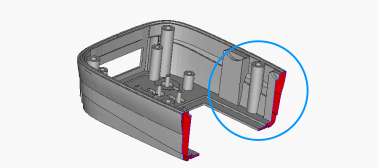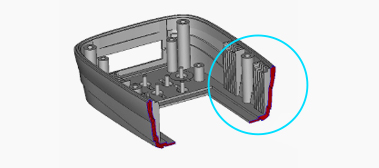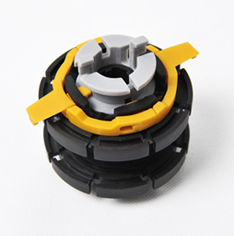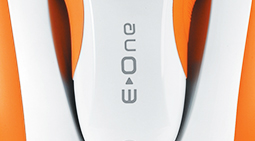
6 Ways to Reduce Costs for
Injection Molding Parts
Are you looking to cut costs for your injection molding parts without compromising on quality and functionality? While injection molding process may seem costly compared to CNC machining and 3D printing, there are opportunities to optimize the part and achieve significant cost savings. Here are 6 injection molding design considerations to save you money.
1. Reduce Material Cost for Injection Molded Parts
Undoubtedly, the prices of plastic materials are continuously rising. Reducing the material of the part without affecting its functionality can reduce part costs, and avoid increased injection time, following by the decreased injection costs. When minimizing material usage for parts, keep the following considerations in mind:
a. Increase part strength by adding reinforcements rather than increasing wall thickness.
b. Trim excess material from thicker sections of the part.
a. Increase part strength by adding reinforcements rather than increasing wall thickness.
b. Trim excess material from thicker sections of the part.
Furthermore, consider the alternative materials. Many plastics offer comparable strength and functionality, and are easier to mold, leading to lower part costs. By substituting materials strategically without compromising product quality, manufacturers can unlock additional cost savings.

Original Design: Thick wall thickness needs more
materials and can cause shrinkage.

Optimized Design: Adding ribs reduces not only
quality issues but materials cost.
2. Avoid the Overly Stringent Tolerance for Part Design
The stricter the plastic part tolerances, the higher the demands on mold accuracy, mold cavity, injection molding process, and inspection. Consequently, the cost of plastic parts increases. Product developers should also be aware of the significant impact of tighter tolerance on the cost of plastic components and mold production. During product design, it is advisable to optimize part design to avoid using excessively stringent tolerance while ensuring the required functionality of the parts.
Factors affecting plastic part tolerances include:
To avoid the part design with overly tight tolerance, considering the following measures:
● Use low shrinkage rate plastics in applications requiring high dimensional accuracy.
● Avoid imposing tight tolerance requirements at mating surfaces such as mold cavities, inserts, slides, etc., as they may introduce additional alignment errors.
● Refrain from the tighter tolerances in the potential warping area on plastic parts. Reinforcements, such as ribs, can be added to mitigate warping.
● Use low shrinkage rate plastics in applications requiring high dimensional accuracy.
● Avoid imposing tight tolerance requirements at mating surfaces such as mold cavities, inserts, slides, etc., as they may introduce additional alignment errors.
● Refrain from the tighter tolerances in the potential warping area on plastic parts. Reinforcements, such as ribs, can be added to mitigate warping.
3. Use Snap-Fit for Fixing Instead of Screws and other Fasteners
The fixation methods for plastic parts include snap-fit, screws, thermal fusion, and ultrasonic welding. Snap-fit allows for quick assembly and disassembly, and it comes with the lowest cost among these options. Using snap-fit can lower the cost of parts while ensuring the requirements for product assembly and functionality. Please refer to our previous article: 6 Design Tips about Snaps
For example, the robot components of a modular robotics in the right figure were developed by Ross Robotics Robot Platform. The parts were connected by snap-fit, which met the functional requirements, and save the part cost.

4. Avoid the Unnecessary Features
Undercut is one of the unnecessary features on injection molded parts. Undercut refers to features on a part that prevent proper mold ejection, such as openings and protrusions located on the upper side in the mold’s opening direction. In molds, undercuts are achieved through side-action mechanisms, which are relatively complex structures and contributed to increased mold costs. Common side-action include angled pins and slides. To lower mold costs, avoiding undercuts in part design is crucial. Here are some key approaches:
a. Some external undercuts can be eliminated by redesigning the parting surface. as shown in figure below.

a) Original Design: External undercut
complex the mold structure.
b) Optimized Design: Prevents external
undercuts that obstruct smooth demolding.
b. Redesign part features to avoid undercuts. Many undercut features on parts can be eliminated through optimized design, thereby avoiding the need for side-action and reducing part mold costs.

a) Original Design: The undercut of hinge
mouth structure needs side-action.
b) Optimized Design: The hinge mouth
can be demolded easily.

5. Be Careful with the Decorative Features
For the cosmetic appearance and decorative features of the parts, as well as any text or symbols on them, it is advisable to have them protrude outward, as during mold processing, they should be recessed to facilitate the machining process, further reducing injection molding cost.
6. Choose Overmolding
Finally, consider the possibility of using overmolding. The liquid silicone rubber molding is cost-effective comparing with aluminum or steel mold. Additionally, the complex structure such as undercut can be achieved easily by this process. However, according to the quantities and other specific requirements about your requirements, please consult an engineering expert if the process is feasible for your parts.
Do you have any thoughts or suggestions on the ways to reduce the injection molding costs? Contact Us to start your next project now.